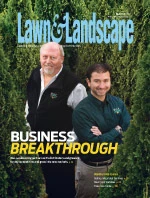 Photo: Jack Robertson Lawn CareTiming is everything, and the same is true in marketing. So Jack Robertson Lawn Care touches customers just when they’re thinking about the outdoors, and reminds prospects to call for service when they’re most likely to be tuned in to lawn care.
Photo: Jack Robertson Lawn CareTiming is everything, and the same is true in marketing. So Jack Robertson Lawn Care touches customers just when they’re thinking about the outdoors, and reminds prospects to call for service when they’re most likely to be tuned in to lawn care.
March means bus-bench advertising, which Robertson has done since 1988. “When people see those benches go up, they know spring is around the corner – they’re an icon in town,” says the Springfield, Ill.-based firm’s president. In his 34 years in business, Robertson has learned nontraditional approaches yield the most response.
“We have spent and wasted a lot of money in a lot of different ways to market,” Robertson says. “I would suggest that we pretty well tried most everything that would be normal and feasible in the lawn care industry, other than telemarketing.”
The bus-bench ads are simple – logo, “call for estimate” and phone number. And they’re strategically placed in areas where Robertson wants to pick up business. He only advertises this way for a short time in late February and March when residents are beginning to think spring, or at least long for it.
Robertson does use traditional forms of advertising, but he is selective and strategic. Take newspaper advertising. “You have to do enough newspaper advertising to make an impact,” he says. “If it’s little and cheap, it won’t work.”
He applies the same attitude to radio marketing. Drive-time is the ideal window for people to listen, but that’s also the most expensive ad slot. Robertson has learned that Sunday afternoons elicit Monday calls for service, and the time slot is a lot less expensive. “If you get a nice Sunday in March and it’s 50 degrees outside, you are not staying at home,” he remarks. “You are in the car. And you’re listening to the radio.”
Meanwhile, the company’s primary marketing focus is on retaining existing customers, and this is accomplished through the Turf Times, a fact sheet containing trends and information for customers that is distributed at the time of application. These informative leave-behinds are updated weekly throughout the growing season so lawn care customers never get the same message twice.
“The best thing you can do in a business of any size is retain your customers,” Robertson says. “We communicate with our customers more than the average company, and that is one way we hope to retain them as best we can.”
Give-aways keep these touch-points fun for Robertson. Several years ago, the company distributed plastic logo cups to customers who received estimates. This was before those plastic cups cropped up everywhere, he adds. “We would see those cups three, four, five years down the road in people’s houses,” he says. Now, customers get a reusable shopping bag with the Robertson Lawn Care logo at the time of estimate.
Come renewal time in February/March, customers receive a packet full of information and an invitation to the Robertson Lawn Care office to pick up a free rain gauge. It’s a simple gesture, and inexpensive. But it lures people to visit the company’s headquarters, which Robertson is quite proud of. “We want them to know where we are,” he says.
Every year, 200 long-standing customers get a special treat. In 2009, Robertson sent these loyal clients a thank-you card at Thanksgiving time with a coupon to pick up a free pumpkin pie at the office. He was overjoyed with the response. Most people guess that about 30 people picked up pies, he says. Not even close. “One hundred and eight pies got picked up – that is a lot,” he says.
In fact, that’s more than a 50 percent return rate if you translate that thank-you marketing tactic to direct mail stats, which are generally 1 percent. And Robertson has launched traditional direct mail campaigns in the past. “It can be efficient, but for us it hasn’t been nearly as efficient as it used to be in the old days,” he says.
The “wow factor” is effective. After all, how many companies in town have a truck with a huge grub on the hood and detailing that’s “NASCAR-ed up,” Robertson points out. Just one truck is decked out, and every year that vehicle is placed on a different route to mix up the exposure.
“The key is to spend marketing dollars as wisely as you can,” Robertson says, noting these fearless advertising strategies work best for his company. He won’t cut his 4 percent marketing budget this year.
“It’s the most interesting part of the business,” he says.
The author is a freelance writer based in Bay Village, Ohio.

Explore the March 2010 Issue
Check out more from this issue and find your next story to read.
Latest from Lawn & Landscape
- ExperiGreen, Turf Masters Brands merge
- EquipmentShare cuts ribbon on new Maryland branch
- Strathmore acquires Royal Tree Service in Montreal
- In a new direction
- The December issue is now live
- Ignite Attachments debuts 80-inch, severe-duty bucket
- EquipmentShare breaks ground on Roswell branch
- NaturaLawn of America adds Schwartz, Medd to operations team





